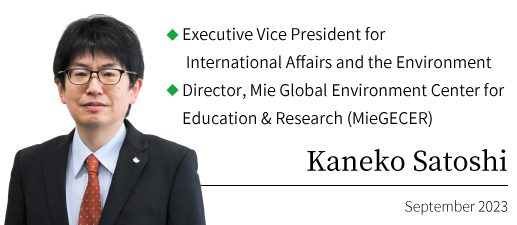1三重大学の概要
Editor’s Postscript on the Environmental Management & SDGs Report of Mie University 2023
The Environmental Management & SDGs Report of Mie University 2023 is the third such annual report to be issued since the publication’s title was changed from Environmental Management Report to Environmental Management & SDGs Report in 2021. This change was made with a view to enhancing Mie University’s initiatives on the environment and SDGs and actively sharing them with the university community and the public.
Climate change is now described as a global crisis. It is a pressing challenge that none of us, and indeed no life form on earth, can avoid. Increasing average temperatures, snow and ice melt, rising sea levels, and similar phenomena caused by global warming are already being observed worldwide. Here in Japan, higher average temperatures, torrential rains, and typhoons have caused considerable damage. Their impact on crops and the ecosystem has become too obvious to ignore.
The Paris Agreement was adopted in 2015 to deal with the challenge of global warming. The countries of the world committed themselves to a common set of goals. Specifically, they agreed to keep the rise in temperature to below 2˚C above pre-industrial levels and preferably limit the increase to 1.5°C. They also agreed to balance greenhouse gas emissions and removals by the end of the century. Action is being taken around the world to achieve these goals. More than 120 countries and regions have declared that they will become carbon-neutral by 2050.
Mie University, as a center of knowledge and platform for training the next generation of leaders, is committed to playing a role in combating climate crisis caused by global warming and building a carbon-free, carbon-neutral society. This report on environmental management and the SDGs is released as part of that commitment.
Chapter 1 provides an overview of Mie University.
Chapter 2, entitled “Special Features,” reports on an environmental symposium held in August (the subject: building a carbon-neutral society from the perspective of diversity and inclusion). Students are about to find themselves in a very different environment as the infrastructure needed to achieve a carbon-neutral society is installed and artificial intelligence (AI) advances. Moreover, there are expected to be major changes in how students choose a career and what types of job candidates employers seek. One of our primary missions as a university, we believe, is to produce graduates capable of adapting to such changing times and working on solutions to environmental and societal challenges. Through the prism of diversity and inclusion, the environmental symposium examined how to develop leaders capable of blazing the path to the future alongside local communities. Faculty, Japanese and international students, and business representatives all contributed to the discussion. Chapter 2 also describes the activities of Mie University and its graduates and students and includes information on specific topics.
Chapter 3 reports on the environmental management and SDGs student platform, social contribution activities by faculty and staff, activities in partnership with the community, the activities of our affiliated schools, and UNESCO Associated School activities.
Chapter 4, entitled “The Sustainable Smart Campus,” describes the steps Mie University is taking to achieve carbon neutrality.
Chapter 5, entitled “Environmental Management and SDGs Education,” provides information on courses given by the Mie Global Environment Center for Education & Research and courses affiliated with the Center for General Education in the environmental management and SDGs field. It also describes the Environmental Internship Program.
Chapter 6, entitled “Environmental Management and SDGs Research,” gives details on research projects on environmental management and the SDGs being conducted by faculty and staff in each of the University’s faculties and graduate schools.
Chapter 7, entitled “Environmental Initiatives and Assessments,” reports on global warming prevention programs, management of laboratory liquid wastes, and environmental risk management.
Chapter 8, entitled “Management Systems,” provides details on the ISO 14001 re-certification process and internal environmental auditing.
Chapter 9, entitled “Third-party Assessments,” describes the mutual assessment process between Mie University and Chubu Electric Power Co., Inc.
Not only does the Mie Global Environment Center for Education & Research review and assess Mie University’s environmental management and SDGs activities. In addition, it works constantly to ensure that the University fulfills its social responsibility in partnership with stakeholders inside and outside the university community and in Japan and overseas. Our goal is to achieve further progress as a dynamic institution capable of creating shared value with local communities. I encourage you to read through the Environmental Management & SDGs Report of Mie University 2023 and share your candid opinions.
